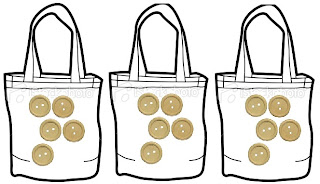The set model involves arranging objects into equal groups. An example of this would be presenting students with a diagram of 3 bags, with 5 buttons in each, and asking the question 'how many buttons altogether?'.
The linear model involves repeated jumps of the same distance on a number line. An example would be giving the students the multiplication problem 5x4 to work out on a number line. By starting on 0 and jumping 4 groups of 5, the student will arrive at the answer.
The combination model involves calculating the number of possible combinations of 2 sets of numbers of objects. An example would be having the students work out the total number of combinations of outfits given 2 shirts and 3 pairs of pants. In my own learning experiences in tutorial activities, we were to work out this same question, using the diagram of our choice. Students may choose to use a tree diagram (see below), or draw a table.
Teachers could use the Shorts and Shirts activity to practice this model.
The final is multiplication model is the area model which uses equal rows of objects (known as arrays) to work out the total. An example of this would be to have the students work out a multiplication problem such as 6x4 using the area model. Students would be expected to design a table (see below) to work out the total.
Division: (often related to the symbol ÷) is the inverse operation of multiplication. A division operation consists of three different parts: the dividend, the divisor, and the quotient.
Division involves splitting a number (dividend) into smaller, equal parts (Origo, 2008). The divisor is the number that indicates how many parts the dividend will be split into, or the number in each part; and the quotient is the number in each part, or the number of parts. As a teacher, we can demonstrate this operation with the assitance of 2 division models. These are: partition model and the quotation model. Learning experiences can be formed around each model to help with the development and understanding of this operation.
The partition model involves sharing (Origo, 2008). We can also call this the sharing model. The total number to be divided is known (dividend) and the number of parts is known (divisor), but the number in each part needs to be found (quotient). An example of this would be to ask the students a question such as '12 buttons are grouped into 3 bags. How many buttons in each bag?'. In symbols, the equation would look like 12÷3=__. Students could use counters to work out the following. By forming 3 piles of counters out of the 12, they can use the one-to-one principle of counting to separate the counters.
The quotation model involves forming equal groups. We can also call this the grouping model. The total number to be divided is known (divisor), the number in each part is known (quotient), but the total number of parts needs to be found (dividend). An example of this would be to ask the students a question such as 'there are 12 buttons grouped into bags, with 4 buttons in each bag. How many bags are there?'. In symbols, the equation would look like 12÷__=4. Again, students could use counters to work out the following. By using one-to-one counting principle, students could start a pile, and count out 4 counters. Start another pile and count out 4 counters etc until all counters have been claimed. This will assist students in recognising that the 12 counters can be split into 3 equal groups (see example below):

.jpg)



.jpg)
2.jpg)